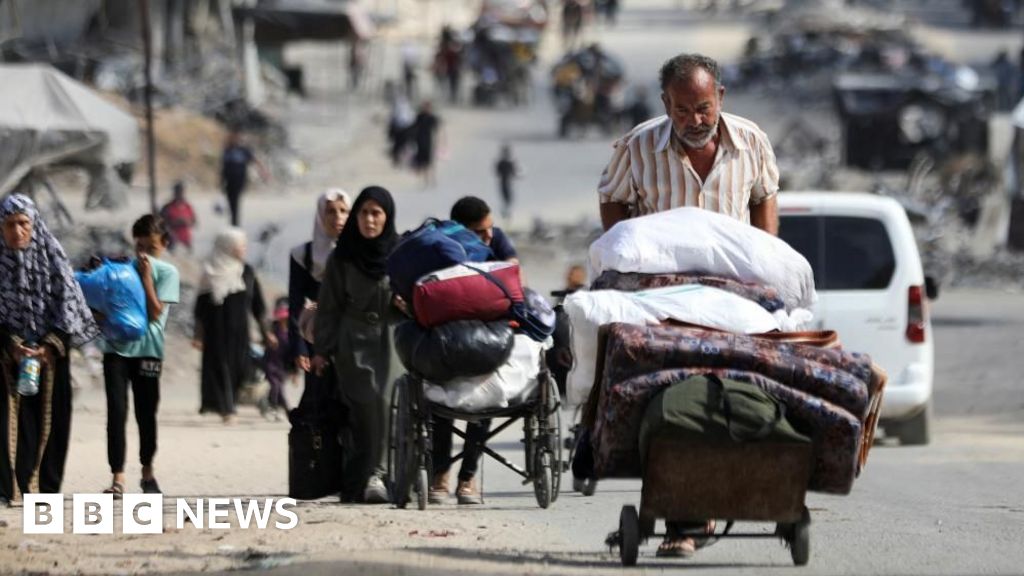
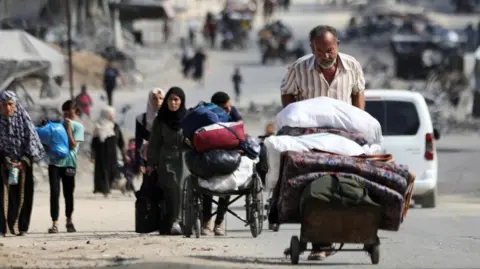 Reuters
ReutersOn Saturday morning, a message was posted on social media by the Israeli military’s Arabic spokesman warning people living in the ‘D5’ area of northern Gaza to move south. D5 is a square on the grid superimposed over maps of Gaza by the Israel Defense Forces (IDF). It is a block that is split into several dozen smaller areas.
The message, the latest in a series, said: “The IDF is operating with great force against the terrorist organisations and will continue to do so for a long time. The designated area, including the shelters located there, is considered a dangerous combat zone. The area must be evacuated immediately via Salah al-Din Road to the humanitarian area.”
A map is attached with a large yellow arrow pointing from block D5 down to the south of Gaza. Salah al-Din Road is the main north-south route. The message is not promising a swift return to the places people have been living in, an area that has been pulverised by a year of repeated Israeli attacks. The heart of the message is that the IDF will be using “great force… for a long time”. In other words, don’t expect to come back any time soon.
The humanitarian area designated by Israel in the message is al-Mawasi, previously an agricultural area on the coast near Rafah. It is overcrowded and no safer than many other parts of Gaza. BBC Verify has tracked at least 18 airstrikes on the area.
Hamas has sent out its own messages to the 400,000 people left in northern Gaza, an area that was once the urban heartland of the Strip with a population of 1.4m. Hamas is telling them not to move. The south, they are told, is just as dangerous. As well as that, Hamas is warning them that they will not be allowed back.
Many people appear to be staying put, despite Israeli airstrikes and artillery bombardments. When I went down to an area overlooking northern Gaza I could hear explosions and see columns of smoke rising. The intensity reminded me of the first months of the war.
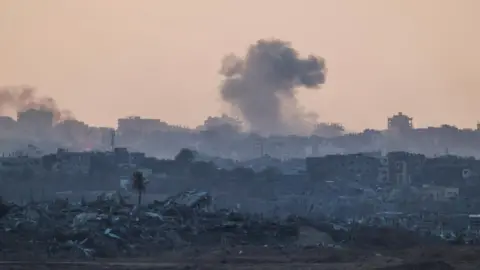 Reuters
ReutersSome of the people who have stayed in northern Gaza when so many others have already fled south are doing so to remain with vulnerable relatives. Others are from families with connections to Hamas. Under the laws of war, that does not automatically make them belligerents.
One tactic that has been used over the last year by civilians who want to avoid IDF operations without taking their chances in the overcrowded and dangerous south of Gaza is to move elsewhere in the north, for example from Beit Hanoun to Gaza City, while the IDF is operating near their homes or shelters. When the army moves on, they return.
The IDF is trying to stop that happening, according to BBC colleagues who are daily contact with Palestinians in Gaza. It is channelling families who are moving in one direction only, down Salah al-Din, the main road to the south.
Israel does not allow journalists to enter Gaza to report the war, except for brief, rare and closely supervised trips with the IDF. Palestinian journalists who were there on 7 October still do brave work. The Committee to Protect Journalists says at least 128 Palestinian media workers in Gaza have been killed since the war began. In northern Gaza, since Israel went back on the offensive, they have been filming panic-stricken families as they flee, often with small children helping out by carrying oversized backpacks.
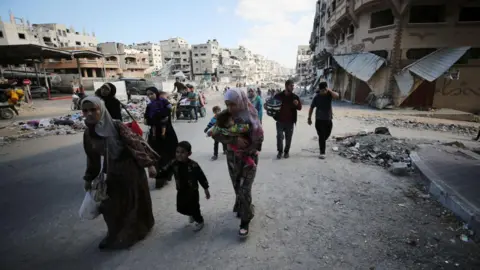 Getty Images
Getty ImagesOne of them sent out a brief interview with a woman called Manar al-Bayar who was rushing down the street carrying a toddler. She was saying as she half-walked, half-ran on the way out of Jabalia refugee camp that “they told us we had five minutes to leave the Fallujah school. Where do we go? In southern Gaza there are assassinations. In western Gaza they’re shelling people. Where do we go, oh God? God is our only chance.”
The journey is hard. Sometimes, Palestinians in Gaza say, people on the move are fired on by the IDF. It insists that Israeli soldiers observe strict rules of engagement that respect international humanitarian law.
But Medical Aid for Palestinians’ head of protection, Liz Allcock, says the evidence presented by wounded civilians suggest that they have been targeted.
“When we’re receiving patients in hospitals, a large number of those women and children and people of, if you like, non-combatant age are receiving direct shots to the head, to the spine, to the limbs, very indicative of the direct targeted attack.”
Once again, the UN and aid agencies who work in Gaza are saying that Israeli military pressure is deepening what is already a humanitarian catastrophe.
Desperate messages are being relayed from the remaining hospitals in northern Gaza, saying that they are running low on fuel to power the generators that keep the hospitals going, and keep badly wounded patients alive. Some hospitals report that their buildings have been attacked by the Israelis.
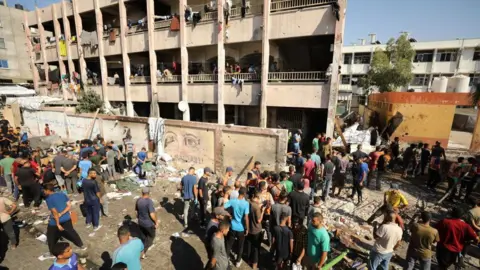 Getty Images
Getty ImagesThe suspicion among Palestinians, the UN and relief agencies is that the IDF is gradually adopting some or all of a new tactic to clear northern Gaza known as the “Generals’ Plan”. It was proposed by a group of retired senior officers let by Major-General (ret) Giora Eiland, who is a former national security adviser.
Like most Israelis they are frustrated and angry that a year into the war Israel still has not achieved its war aims of destroying Hamas and freeing the hostages. The Generals’ Plan is a new idea that its instigators believe can, from Israel’s perspective, break the deadlock.
At its heart is the idea that Israel can force the surrender of Hamas and its leader Yahya Sinwar by increasing the pressure on the entire population of the north. The first step is to order civilians to leave along evacuation corridors that will take them south of Wadi Gaza, an east-west stream that has become a dividing line in Gaza since the Israeli invasion last October.
Giora Eiland believes Israel should have done a deal straight away to get the hostages back, even if it meant pulling out of Gaza entirely. A year later, other methods, he says, are necessary.
In his office in central Israel, he laid out the heart of the plan.
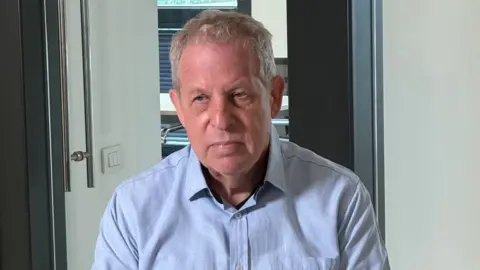 Oren Rosenfeld/BBC
Oren Rosenfeld/BBC“Since we already encircled the northern part of Gaza in the past nine or 10 months, what we should do is the following thing to tell all the 300,000 residents [that the UN estimates is 400,000] who still live in the northern part of Gaza that they have to leave this area and they should be given 10 days to leave through safe corridors that Israel will provide.
“And after that time, all this area will become to be a military zone. And all the Hamas people will still, though, whether some of them are fighters, some of them are civilians… will have two choices either to surrender or to starve.”
Eiland wants Israel to seal the areas once the evacuation corridors are closed. Anyone left behind would be treated as an enemy combatant. The area would be under siege, with the army blocking all supplies of food, water or other necessities of life from going in. He believes the pressure would become unbearable and what is left of Hamas would rapidly crumble, freeing the surviving hostages and giving Israel the victory it craves.
The UN World Food Programme says that the current offensive in Gaza is having a “disastrous impact on food security for thousands of Palestinian families”. The main crossings into northern Gaza, it says, have been closed and no food aid has entered the strip since 1 October. Mobile kitchens and bakeries have been forced to stop work because of air strikes. The only functioning bakery in the north, which is supported by WFP, caught fire after it was hit by an explosive munition. The position in the south is almost as dire.
It is not clear whether the IDF has adopted the Generals’ Plan in part or in full, but the circumstantial evidence of what is being done in Gaza suggests it is at the very least a strong influence on the tactics being used against the population. The BBC submitted a list of questions to the IDF, which were not answered.
The ultra-nationalist extremists in Benjamin Netanyahu’s cabinet want to replace Palestinians in northern Gaza with Jewish settlers. Among many statements he’s made on the subject, the finance minister Bezalel Smotrich has said “Our heroic fighters and soldiers are destroying the evil of Hamas, and we will occupy the Gaza Strip… to tell the truth, where there is no settlement, there is no security.”

